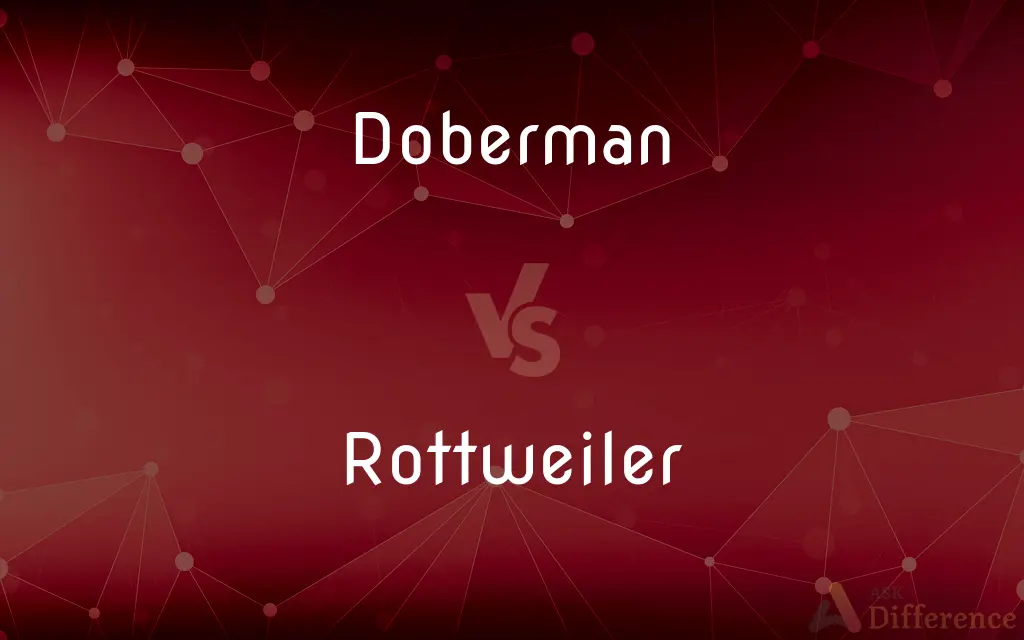Doberman vs. Rottweiler — What's the Difference?
By Tayyaba Rehman & Maham Liaqat — Updated on April 21, 2024
Dobermans are known for their sleek, muscular build and alert demeanor, whereas Rottweilers are stockier with a more powerful build.

Difference Between Doberman and Rottweiler
Table of Contents
ADVERTISEMENT
Key Differences
Dobermans are recognized for their slender, athletic physique, making them exceptionally agile and fast. On the other hand, Rottweilers have a broader and more robust frame, which contributes to their immense strength and endurance. This difference in build affects their respective roles and activities, with Dobermans excelling in tasks requiring speed and Rottweilers in those needing power.
Dobermans often have a sharp, alert expression complemented by their pointed ears and long muzzles. In contrast, Rottweilers display a more rounded head with floppy ears and a shorter, broader muzzle. These physical traits influence their facial expressions, giving Dobermans a more intense look while Rottweilers appear calmer and more steadfast.
The temperament of a Doberman is typically energetic, intelligent, and sometimes standoffish with strangers. Whereas Rottweilers are known for their loyalty, confidence, and protective nature, making them excellent guard dogs. This difference in temperament reflects their historical uses, with Dobermans originally bred for protection and Rottweilers for herding and guarding.
Regarding training, Dobermans are highly trainable due to their eagerness to please and quick learning ability. Rottweilers, while also trainable, may show a more independent streak, requiring a firm and consistent training approach. This aspect is crucial for potential owners to consider, depending on their experience with dogs and the time they can dedicate to training.
In terms of health, Dobermans are prone to certain genetic conditions like dilated cardiomyopathy and von Willebrand's disease. Rottweilers also have their share of health concerns, notably hip dysplasia and certain types of cancer. Prospective owners should be aware of these health issues and prepared for possible veterinary visits and treatments.
ADVERTISEMENT
Comparison Chart
Build
Sleek, muscular
Stocky, powerful
Facial Features
Pointed ears, long muzzle
Floppy ears, short muzzle
Temperament
Energetic, intelligent
Loyal, protective
Training
Highly trainable
Requires firm, consistent training
Health Concerns
Cardiomyopathy, von Willebrand's
Hip dysplasia, cancer
Compare with Definitions
Doberman
A medium-large breed known for its agility and guard skills.
The Doberman swiftly alerted its owners to the unseen trespassers.
Rottweiler
Typically very loyal and good with families.
The family's Rottweiler was protective of the children.
Doberman
Characterized by a sleek coat and athletic build.
The Doberman's sleek coat shimmered under the summer sun.
Rottweiler
Requires consistent and firm training.
They enrolled their Rottweiler in an advanced obedience class.
Doberman
Sensitive to cold due to their thin coat.
During winter, the Doberman wore a coat to stay warm.
Rottweiler
A powerful breed used historically for herding and guarding.
The Rottweiler gently herded the lost sheep back to the pen.
Doberman
Highly intelligent and easily trainable.
Her Doberman learned the new commands in just a few tries.
Rottweiler
Known for a stocky build and immense strength.
The Rottweiler pulled the heavy cart with ease.
Doberman
Originally bred as a protection dog.
The estate was guarded by a highly trained Doberman.
Rottweiler
Can be prone to obesity if not exercised.
They kept their Rottweiler active to prevent weight gain.
Doberman
A Doberman pinscher.
Rottweiler
The Rottweiler (, UK also ) is a breed of domestic dog, regarded as medium-to-large or large. The dogs were known in German as Rottweiler Metzgerhund, meaning Rottweil butchers' dogs, because their main use was to herd livestock and pull carts laden with butchered meat to market.
Doberman
Medium large breed of dog of German origin with a glossy black and tan coat; used as a watchdog
Rottweiler
A dog of a large breed developed in Germany, having a muscular body, a broad head, and a short black coat with tan markings on the face and legs.
Rottweiler
Alternative case form of Rottweiler
Rottweiler
German breed of large vigorous short-haired cattle dogs
Common Curiosities
What is the typical lifespan of a Doberman?
Dobermans typically live between 10 to 12 years.
What is the typical lifespan of a Rottweiler?
Rottweilers generally have a lifespan of 8 to 10 years.
How do Dobermans handle cold weather?
Dobermans are sensitive to cold and may need protective clothing in colder climates.
Are Dobermans good with children?
Dobermans can be good with children if properly socialized and trained from a young age.
Are Rottweilers good family pets?
Yes, Rottweilers can be excellent family pets with proper training and socialization.
Are Rottweilers aggressive?
Rottweilers can be strong-willed and protective, which might be perceived as aggression if not properly trained and socialized.
What are the exercise needs of a Doberman?
Dobermans require regular, vigorous exercise to maintain their health and energy levels.
What are the exercise needs of a Rottweiler?
Rottweilers need daily exercise but will adapt to moderate levels as long as it's consistent.
Are Dobermans easy to train?
Yes, Dobermans are known for their intelligence and eagerness to please, making them relatively easy to train.
What health issues are common in Dobermans?
Dobermans are prone to conditions like dilated cardiomyopathy and von Willebrand's disease.
What health issues are common in Rottweilers?
Common issues include hip dysplasia and certain types of cancer.
Can Rottweilers live comfortably in an apartment?
Rottweilers can live in apartments, but they need sufficient space and regular exercise to manage their size and energy.
How do Rottweilers handle hot weather?
Rottweilers can tolerate moderate heat, but should be watched closely and provided plenty of water and shade.
Can Dobermans be apartment pets?
Dobermans can adapt to apartment living if they receive enough exercise and mental stimulation.
What should potential owners know about the grooming needs of these breeds?
Both Dobermans and Rottweilers have relatively low grooming needs, requiring regular brushing and occasional baths, but Rottweilers may shed more than Dobermans.
Share Your Discovery

Previous Comparison
Bang vs. Crash
Next Comparison
Concur vs. DissentAuthor Spotlight
Written by
Tayyaba RehmanTayyaba Rehman is a distinguished writer, currently serving as a primary contributor to askdifference.com. As a researcher in semantics and etymology, Tayyaba's passion for the complexity of languages and their distinctions has found a perfect home on the platform. Tayyaba delves into the intricacies of language, distinguishing between commonly confused words and phrases, thereby providing clarity for readers worldwide.
Co-written by
Maham Liaqat













































